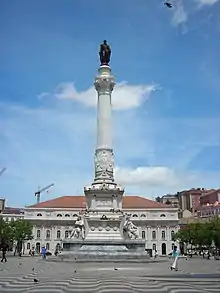Column of Pedro IV
The Column of Pedro IV (Portuguese: Coluna de D. Pedro IV) is a monument to King Peter IV of Portugal and the Algarves, located in the centre of Rossio Square in Lisbon, Portugal. The monument was erected in 1870.
| Column of Pedro IV Coluna de D. Pedro IV | |
|---|---|
 The Column of Pedro IV | |
| Location | Rossio Square, Lisbon, Portugal |
History and details
.png.webp)
King John VI had a monument to the Constitution built in 1821 on the spot the column stands today, which was rased two years later by the same king, after Infante Michael of Portugal (supported by Queen Carlota Joaquina) successfully led a counter-revolution to reinstate the absolute monarchy.
A first monument to King Peter IV was erected in 1852, with Queen Mary II (King Peter's daughter) laying the cornerstone. The monument consisted simply of a pedestal, which the Lisboners referred to as "o galheteiro" ("the cruet-stand") due to its ungraceful form. This primitive monument was demolished in 1864, after serving as the base for a temporary statue of Hymenaeus during the wedding ceremonies of King Peter V in 1858 and King Louis I in 1862.
The current marble statue was erected on top of a 75-foot (~ 23 metres) column in 1870.[1] The statue is of Peter IV, King of Portugal, who was also the first Emperor of Brazil, as Peter I. His bronze statue stands atop of a tall Corinthian order column, depicting him in a general's uniform and royal cloak, his head crowned in laurels, and holding the Constitutional Charter of 1826 in his right hand. At the base of the column, there are the four female allegorical figures of Justice, Wisdom, Strength, and Moderation, qualities attributed to the King.
There is an urban legend that the statue atop the Column of King Pedro IV had actually been originally designed for the Emperor Maximilian I of Mexico. As the Mexican emperor was shot in 1867, shortly before the completion of the statue, it is said that the statue was then bought for the beautification of Rossio Square. Several historians, such as José Augusto, have proved this urban legend to be incorrect, pointing out the details of the statue that clearly symbolize the Portuguese King, such as the Portuguese Coat of Arms on the buttons, the collar of the Order of the Tower and Sword, and the Constitutional Charter of 1826, penned by Peter himself.
References
- "Archived copy". Archived from the original on 24 September 2015. Retrieved 5 April 2015.CS1 maint: archived copy as title (link)